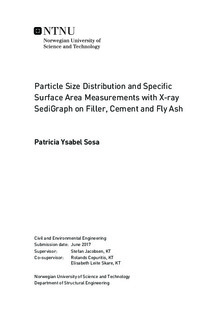Particle Size Distribution and Specific Surface Area Measurements with X-ray SediGraph on Filler, Cement and Fly Ash
Master thesis
Permanent lenke
http://hdl.handle.net/11250/2455576Utgivelsesdato
2017Metadata
Vis full innførselSamlinger
Sammendrag
The focus of this thesis is producing the Particle Size Distribution (PSD) of filler, cement and fly ash using X-ray sedimentation technique. The Micromeritics SediGraph III Plus (5125) applies the sedimentation theory to determine the particle size and directly measures the particle mass through X-ray absorption. Particle size is measured in equivalent spherical diameter, the diameter of a sphere of the same material with the same falling rate. By using Stokes law to calculate the particle falling rate, the SediGraph is able to determine the size of the particle that has fallen beyond a specific analysis point of the analysis cell. Concrete performance can be optimized through concrete Micro-proportioning by adjusting the grading of fines to control the matrix rheology. The Specific Surface Area (SSA) is however a better parameter in describing the fineness and is easier to apply in practice. The SSA can be calculated from the size distribution. An accurate analysis of particles with particle size below 5 µm is therefore significant as most of the SSA comes from the smallest particles. The SediGraph was used to determine the distribution of Velde Fine filler, Industrisement and Fly Ash (FA) with a particle size range of 1 125 µm. The precision of the SediGraph analysis is mainly dependent on how well dispersed the particles are in the liquid. Studies of suitable dispersing liquids concluded that the SediSperse A-12 is the most promising liquid. The liquid density and liquid viscosity are temperature dependent, meaning that the temperature during the analysis must be kept stable for accurate analysis. The procedure for determining PSD including sampling, rinsing and agitation seems to be well-developed and provides reproducible results. In addition, the PSD of the same material shows good repeatability. The SSA calculated from the PSD indicates that 90 % of the SSA is concentrated in the particle size below 20 µm, where more than 50 % of the SSA is generated from the particles with particle size below 5 µm.
